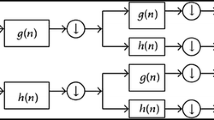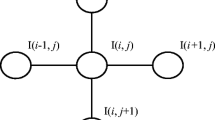Abstract
This paper presents a new image denoising algorithm based on wavelet transform and nonlinear diffusion. Although the wavelet domain diffusion methods are very effective in image denoising, the salient artifacts are still produced. On the other hand, the image domain diffusion methods output the denoised image with fewer artifacts. So, unlike the previous denoising methods employing wavelet transform and diffusion scheme, the proposed method implements the diffusion not only in the wavelet domain but also in the image domain. The new method is called image denoising method combining the wavelet domain diffusion and the image domain diffusion (WDD-IDD). In the process of denoising, the initial denoised image is obtained by carrying out the wavelet domain isotropic diffusion. And then, the final denoised image is produced by applying the image domain anisotropic diffusion on the initial denoised image. It is noted that the image domain anisotropic diffusion scheme is constructed based on the feature of initial denoised image. In addition, to exemplify the power of the proposed method, the processing is restricted to the non-subsampled shearlet transform (NSST) domain which can better capture the geometry features of image than other wavelet transform. The tests show that the proposed WDD-IDD produces a better result in term of peak signal-to-noise ratio (PSNR), structural similarity (SSIM), and visual effect compared to the related methods.



Similar content being viewed by others
References
Blu T, Luisier F (2007) The SURE-LET approach to image denoising. IEEE Trans Image Process 16(11):2778–2786
Chang SG, Yu B, Vetterli M (2000) Adaptive wavelet thresholding for image denoising and compression. IEEE Trans Image Process 9(9):1532–1546
Chen GY, Bui TD, Krzyzak A (2005) Image denoising with neighbour dependency and customized wavelet and threshold. Pattern Recogn 38:115–124
Donoho DL, Johnstone IM (1994) Ideal spatial adaptation via wavelet shrinkage. Biometrika 81:425–455
Donoho DL, Johnstone IM (1995) Adapting to unknown smoothness via wavelet shrinkage. J Amer Statist Assoc 90(432):1200–1224
Easley GR, Labate D, Lim W (2008) Sparse directional image representations using the discrete shearlet transform. Appl Comput Harmon Anal 25:25–46
Geng P, Tian S, Lu K (2016) Multifocus Image Fusion by the Sum of Local Variance Energy. J. Inf. Hiding Multimedia Signal Process 7(1):175–183
Guo F, Wang H (2015) Multi-wavelet Feature Extraction Method for Variable Illumination Face Recognition. J. Inf. Hiding Multimedia Signal Process 6(5):987–996
Huang HC, Chang FC (2015) Error resilience for compressed sensing with multiple-channel transmission. . J. Inf. Hiding Multimedia Signal Process 6(5):847–856
Liu QH, Lin M, Li B (2015) Image denoising using multivariate model in shiftable complex directional pyramid domain and principal neighborhood dictionary in spatial domain. Opt Int J Light Electron Opt 126(9):967–971
Mandava AK, Regentova EE (2011) Image denoising based on adaptive nonlinear diffusion in wavelet domain. J Electron Imaging 20(3):033016–033016
Mihcak MK, Kozintsev I, Ramchandran K, Moulin P (1999) Low-complexity image denoising based on statistical modeling of wavelet coefficients. IEEE Signal Process Lett 6(12):300–303
Perona P, Malik J (1990) Scale-Space edge detection using anisotropic diffusion. IEEE Trans Pattern Anal Mach Intell 12(7):629–639
Pižurica A, Philips W (2006) Estimating the probability of the presence of a signal of interest in multiresolution single- and multiband image denoising. IEEE Trans Image Process 15(3):645–665
Portilla J, Strela V, Wainwright MJ, Simoncelli EP (2003) Image denoising using scale mixtures of gaussians in the wavelet domain. IEEE Trans Image Process 12(11):1338–1351
Scharr H, Weickert J (2000) An anisotropic diffusion algorithm with optimized rotation invariance. Mustererkennung, Springer Berlin Heidelberg, pp 460–467
Sendur L, Selesnick IW (2002) Bivariate shrinkage with local variance estimation. IEEE Signal Process Lett 9(12):438–441
Tao D, Jin L, Wang Y, Yuan Y, Li X (2013) Person re-identification by regularized smoothing kiss metric learning. IEEE T Circ Syst Vid 23(10):1675–1685
Tao D, Lin X, Jin L, Li X (2016) Principal component 2-D long short-term memory for font recognition on single Chinese characters. IEEE Trans Cybern 46(3):756–765
Wang Z, Bovik AC, Sheikh HR, Simoncelli EP (2004) Image quality assessment: From error visibility to structural similarity. IEEE Trans Image Process 13(4):600–612
Wang XY, Liu YC, Zhang N, Wu CJ, Yang HY (2015) An edge-preserving adaptive image denoising. Multimed Tools Appl 74(24):11703–11720
Wang Y, Wang Z, Tao D, Zhuo S, Xu X, Pu S, Song M (2016a). AllFocus: patch-based video out-of-focus blur reconstruction. IEEE T Circ Syst Vid (in press)
Wang Z, Chen M, Meng X, Tang L (2016b) Bimodal Multi-feature Fusion based on quaternion fisher discriminant analysis. J. Inf. Hiding Multimedia Signal Process 7(1):72–79
Weickert J (1998) Anisotropic diffusion in image processing. Teubner, Stuttgart
Zhang X, Feng X (2014) Multiple-step local Wiener filter with proper stopping in wavelet domain. J Vis Commun Image R 25(2):254–262
Zhang X, Feng X, Wang W, Zhang S, Dong Q (2013) Gradient-based Wiener filter for image denoising. Comput Electr Eng 39(3):934–944
Zhong J, Sun H (2008) Wavelet-based multiscale anisotropic diffusion with adaptive statistical analysis for image restoration. . IEEE Trans Circ Syst I Regul Pap 55(9):2716–2725
Acknowledgments
This work is partially supported by National Natural Science Foundation of China (Grant No. 61401383) and Natural Science Foundation of Xianyang Normal University (Grant No. 14XSYK006) and Qinglan Talent Program of Xianyang Normal University (Grant No. XSYQL201503).
Author information
Authors and Affiliations
Corresponding author
Rights and permissions
About this article
Cite this article
Zhang, X. A denoising approach via wavelet domain diffusion and image domain diffusion. Multimed Tools Appl 76, 13545–13561 (2017). https://doi.org/10.1007/s11042-016-3778-3
Received:
Revised:
Accepted:
Published:
Issue Date:
DOI: https://doi.org/10.1007/s11042-016-3778-3




